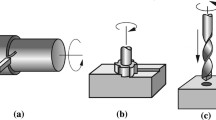Abstract
Modeling machining operations has been a challenge since the 1900s. It has been by empirical, science-based, and computer-based modeling, which started with FEM by the 1970s. For success material, rupture, friction, and convection have to be correctly modeled. Computation time has always been one of the main limitations for accurately describing heat propagation on machining. The present work proposes and tests a hybrid model using an explicit algorithm for the chip formation and an implicit one for heat propagation. Heat flux on workpiece and tool were obtained by the explicit and used as input to the implicit. Simulated results were in good agreement with experimental end milling for very short periods of computer time.
Similar content being viewed by others
References
Krause F-L, Kimura F, Kjellberg T, Lu SC-Y, van der Wolf, Alting L, ElMaraghy HA, Eversheim W, Iwata K, Suh NP, Tipnis VA, Week M (1993) A.C.H, product modelling. CIRP Ann Manuf Technol 42(2):695–706. doi:10.1016/S0007-8506(07)62532-3
Merchant ME (1998) An interpretive look at 20th century research on modeling of machining. Mach Sci Technol 2(2):p157–p163
van Luttervelt CA, Childs THC, Jawahir IS, Klocke F, Venuvinod PK, Altintas Y, Armarego E, Dornfeld D, Grabec I, Leopold J, Lindstrom B, Lucca D, Obikawa T, Shirakashi, Sato H (1998) Present situation and future trends in modelling of machining operations progress report of the CIRP Working Group ‘Modelling of Machining Operations’. CIRP Ann Manuf Technol 47(2):587–626. doi:10.1016/S0007-8506(07)63244-2
Coelho RT, Ng E, Elbestalwi M (2007) Tool wear when turning hardened AISI 4340 with coated PCBN tools using finishing cutting conditions. Intl J Mach Tools Manuf 47:263–272
Umbrello D (2008) Finite element simulation of conventional and high speed machining of Ti6Al4V alloy. J Mater Process Technol 196(1–3):79–87. doi:10.1016/j.jmatprotec.2007.05.007
Sandstrom DR, Hodowany JN (1998) Modeling the physics of metal cutting in high-speed machining. Mach Sci Technol 2(2):343–353
Marusich TD, Ortiz M (1995) Modelling and simulation of high-speed machining. Int J Numer Methods Eng 38(21):3675–3694. doi:10.1002/nme.1620382108
Filice L, Micari F, Rizzuti S, Umbrello D (2008) Dependence of machining simulation effectiveness on material and friction modelling. Mach Sci Technol 12(3):370–389
Sartkulvanich P, Altan T (2005) Effects of flow stress and friction models in finite element simulation of orthogonal cutting—a sensitivity analysis. Mach Sci Technol (Issue 9):1–26. doi:10.1081/MST-200051211
Shi J, Liu CR (2004) The influence of material models on finite element simulation of machining. J Manuf Sci Eng 126(4):849–857. doi:10.1115/1.1813473
Anurag S, Guo YB, Horstemeyer MF (2009) The effect of materials testing modes on finite element simulation of hard machining via the use of internal state variable plasticity model coupled with experimental study. Comput Struct 87(5–6):303–317. doi:10.1016/j.compstruc.2009.01.001
Bil H, Kılıç SE, Tekkaya AE (2004) A comparison of orthogonal cutting data from experiments with three different finite element models. Int J Mach Tools Manuf 44(9):933–944. doi:10.1016/j.ijmachtools.2004.01.016
Bao Y, Wierzbicki T (2005) On the cut-off value of negative triaxiality for fracture. Eng Fract Mech 72(7):1049–1069. doi:10.1016/j.engfracmech.2004.07.011
Wierzbicki T, Bao Y, Lee Y-W, Bai Y (2005) Calibration and evaluation of seven fracture models. Int J Mech Sci 47(4–5):719–743. doi:10.1016/j.ijmecsci.2005.03.003
Shirakashia T, Obikawa T (1998) Recent progress and some difficulties in computational modeling of machining. Mach Sci Technol 2(2):277–301. doi:10.1080/10940349808945672
Ceretti E, Filice L, Umbrello D, Micari F (2007) ALE simulation of orthogonal cutting: a new approach to model heat transfer phenomena at the tool-chip interface. CIRP Ann Manuf Technol 56(1):69–72. doi:10.1016/j.cirp.2007.05.019
Umbrello D, Filice L, Micari F, Settineri L (2005) A simple model for predicting the thermal flow on the tool in orthogonal cutting process. Proceedings “8th CIRP International Workshop on Modeling of Machining Operations”, Chemnitz (Germany), 10–11 May, pp. 191–197
Bergman TL, Lavine AS, Incropera FP, DeWitt DP (1985) Fundaments of heat and mass transfer, School of Mechanical Engineering Purdue University. John Wiley & Sons, Inc
Guo YB, Anurag S, Jawahir IS (2009) A novel hybrid predictive model and validation of unique hook-shaped residual stress profiles in hard turning. CIRP Ann Manuf Technol 58(1):81–84. doi:10.1016/j.cirp.2009.03.110
Pabst R, Fleischer J, Michna J (2010) Modelling of the heat input for face-milling processes. CIRP Ann Manuf Technol 59(1):121–124. doi:10.1016/j.cirp.2010.03.062
Davies MA, Ueda T, M'Saoubi R, Mullany B, Cooke AL (2007) On the measurement of temperature in material removal processes. CIRP Ann Manuf Technol 56(2):581–604. doi:10.1016/j.cirp.2007.10.009
Fleischer J, Pabst R, Kelemen S (2007) Heat flow simulation for dry machining of power train castings. CIRP Ann Manuf Technol 56(1):117–122. doi:10.1016/j.cirp.2007.05.030
Author information
Authors and Affiliations
Corresponding author
Rights and permissions
About this article
Cite this article
Coelho, R.T., de Oliveira, J.F.G. & Nascimento, C.H. Thermal analysis of chip formation using FEM and a hybrid explicit-implicit approach. Int J Adv Manuf Technol 77, 235–240 (2015). https://doi.org/10.1007/s00170-014-6458-3
Received:
Accepted:
Published:
Issue Date:
DOI: https://doi.org/10.1007/s00170-014-6458-3




